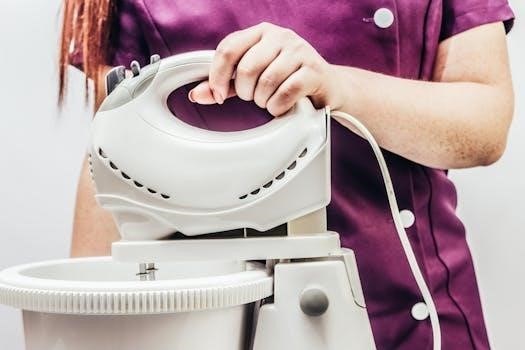Tommee Tippee Bottle Warmer Instruction Manual⁚ A Comprehensive Guide
Welcome to your comprehensive guide for using the Tommee Tippee bottle warmer․ This manual will provide you with essential instructions for safely and effectively warming your baby’s bottles and food jars․ We will cover setup, usage, cleaning, and safety aspects․

Tommee Tippee bottle warmers are designed to gently and evenly heat breast milk or formula to the ideal temperature for your baby․ These warmers utilize a water bath system, ensuring milk is warmed without creating hot spots, preserving essential nutrients․ The bottle warmer is compact and portable, making it convenient for use at home or when traveling․ Tommee Tippee offers various models, including electric and portable options, catering to different needs․ With easy-to-use controls and compatibility with most bottle sizes and brands, Tommee Tippee bottle warmers offer a safe and efficient solution․ They help parents to quickly prepare a feed at optimal temperature․ Some models also include features for warming baby food jars․ This guide will provide you with all the information needed to use the warmer effectively and safely․ The goal of this manual is to help parents quickly and safely prepare warm feeds for their babies with ease․
Preparing the Bottle Warmer for Use
Before using your Tommee Tippee bottle warmer for the first time, it’s crucial to set it up correctly․ Begin by placing the unit on a clean, dry, and stable kitchen work surface․ Ensure that the bottle warmer is positioned away from water sources and edges to prevent accidental spills or falls․ Carefully remove all packaging materials, and familiarize yourself with the parts of the warmer, including the easy lift cradle if it has one․ Check that the plug is undamaged․ Prior to plugging in the device, double-check that the warmer’s interior is clean and dry․ When using the warmer for the first time, it’s a good practice to run it through a warming cycle with water only, without a bottle, to ensure that it is functioning as intended․ This initial setup is an important step for optimal and safe usage․ This process prepares your device for future use with bottles and food․
Water Level Guidelines
Maintaining the correct water level in your Tommee Tippee bottle warmer is essential for safe and effective operation․ For warming bottles, fill the warmer with water to approximately 10mm below the rim or to the inside edge using a jug or bottle․ For smaller bottles, fill to the underside of the screw ring․ Never allow the water to overflow or rise above the neck of the bottle․ This ensures that the bottle is heated evenly and prevents spills․ When warming food jars, the water level must be below the rim of the jar to avoid water overflowing into the food․ Always use a clean measuring jug or bottle to add water․ Ensure the water level is lower than the rim of the jar before starting the warming process․ The correct level also allows for consistent warming and prevents damage to the warmer unit․

Warming Bottles
To effectively warm bottles using your Tommee Tippee warmer, ensure the bottle is filled and placed inside the unit with the bottle hood on․ Fill the warmer with water according to the guidelines, typically to about 10mm below the rim․ Before plugging in, make sure the food and bottle warmer is switched to the correct setting, usually indicated on the control dial․ Once plugged in and switched on, the warmer will begin to heat the water․ The time required to warm the bottle will vary depending on the initial temperature of the milk and the bottle type․ The Tommee Tippee warmer is designed to gently heat milk to the perfect temperature, typically in a matter of minutes․ Always check the temperature of the milk before feeding to ensure it is safe for your baby․
Bottle Placement and Hood Usage
Proper bottle placement within the Tommee Tippee bottle warmer is crucial for effective and even heating․ Always place the filled bottle into the warmer, ensuring it sits securely within the unit․ It is recommended to keep the bottle hood, or teat, on the bottle during the warming process․ This helps to maintain hygiene and prevent contamination․ Ensure that the bottle is standing upright to avoid any spillage during the warming cycle․ The bottle should be centered within the warmer to allow for consistent heating․ Avoid placing the bottle at an angle or overcrowding the unit, as this may affect the warming process․ Correct placement ensures that the milk heats evenly and safely․
Using the Warmer to Keep Milk Warm
The Tommee Tippee bottle warmer can also be utilized to keep milk warm during feeds․ After the initial warming cycle, the bottle can be placed back into the warmer to maintain the desired temperature․ Using the appropriate setting, the warmer’s thermostat will consistently regulate the water temperature․ This prevents the milk from becoming too cold while you are feeding your baby․ This feature is particularly helpful during longer feeding sessions or if your baby needs breaks․ It is important to note that the warmer is designed to maintain a warm temperature, not to reheat cold milk․ Always check the temperature of the milk before feeding your baby․

Warming Baby Food Jars

The Tommee Tippee bottle warmer is also suitable for warming jars of baby food․ Before placing a jar in the warmer, always remove the lid to prevent pressure buildup during the heating process․ Once the lid is removed, place the jar directly into the warmer․ It’s crucial to ensure that the water level within the warmer remains below the rim of the jar to prevent water from entering the food․ The same heating principles apply as with warming bottles, however, you will use a different setting․ Check the food’s temperature before feeding it to your baby․ The warmer is designed for gentle warming, not to cook or boil the contents․
Preparing Jars for Warming
Before placing any baby food jar into the Tommee Tippee bottle warmer, it is imperative to prepare it correctly․ First and foremost, always remove the lid from the jar․ This step is crucial to prevent the buildup of pressure inside the jar during the warming process, which could lead to the jar cracking or the food exploding․ After removing the lid, inspect the jar to ensure that there are no cracks or damages to the glass․ Make sure the jar is suitable for warming and that the contents are appropriate for your baby’s age․ It is also good practice to stir the food after warming, ensuring even heat distribution and to check the temperature of the food․
Water Level for Jar Warming
When using the Tommee Tippee bottle warmer to heat baby food jars, maintaining the correct water level is crucial for safe and effective operation․ It is essential to ensure the water level is always below the rim of the jar․ Fill the warmer with water to the inside edge, using either a jug or a bottle․ This prevents the water from overflowing and getting into the jar, which can affect the consistency and safety of the food․ The water should not rise above the neck of the bottle either․ Always check the water level before plugging in the unit, and during the warming process, if necessary, to ensure the water level is maintained correctly․
Cleaning and Maintenance
Proper cleaning and maintenance of your Tommee Tippee bottle warmer are essential for its continued performance and hygiene․ Before cleaning, always unplug the unit and allow it to cool completely․ This prevents any risk of burns or electrical shock․ The warmer should be wiped down with a damp cloth after each use to remove any spills or residue․ Avoid using abrasive cleaners or solvents, as these can damage the unit’s surface․ Periodically, the warmer should be descaled to remove mineral deposits that can accumulate over time, which affect its efficiency․ Follow the descaling instructions carefully to ensure proper maintenance and longevity of your bottle warmer․
Descaling Instructions
Descaling your Tommee Tippee bottle warmer is crucial to maintain its optimal performance․ Limescale buildup from mineral deposits in water can hinder the device’s heating efficiency․ To descale, unplug the warmer and allow it to cool completely․ Then, prepare a descaling solution using a mixture of white vinegar and water, following the manufacturer’s recommended ratio․ Fill the warmer with this solution, ensuring not to exceed the maximum fill line․ Let the solution sit inside the warmer for a specified period, usually around 30 minutes․ Afterwards, empty the solution and thoroughly rinse the warmer with clean water to remove any remaining descaling agent․ Repeat the process if necessary․ Regularly descaling will help prolong the life of your bottle warmer․
Safety Precautions
When using the Tommee Tippee bottle warmer, always prioritize safety․ Keep the warmer and its power cord out of reach of children to prevent accidents and burns․ Never leave the bottle warmer unattended while it is in use․ Always ensure the bottle is placed correctly within the warmer to avoid spills or uneven heating․ Do not overfill the warmer with water, as this could cause overflow and potential hazards․ Before each use, check the power cord and plug for any damage․ Unplug the warmer immediately after use and allow it to cool completely before cleaning or storing․ Regularly check the water level during operation to prevent the warmer from running dry, which could lead to overheating․ Always follow these safety measures to ensure the safe and proper use of your Tommee Tippee bottle warmer․
Keeping Out of Reach of Children
The Tommee Tippee bottle warmer, like any electrical appliance, presents potential hazards if not used correctly, especially around children․ Always ensure that the bottle warmer and its power cord are placed well out of children’s reach․ This is crucial to prevent them from pulling the unit down, potentially scalding themselves with hot water or the warmed contents․ Never allow children to play with or near the bottle warmer․ Store the warmer in a secure location when not in use, away from curious hands․ The power cord should be neatly tucked away to avoid tripping hazards․ Educate older children about the potential dangers of the warmer․ Keeping the bottle warmer out of reach of children is a vital safety precaution that must be followed at all times․ Always remember to prioritize your child’s safety․
Troubleshooting Common Issues
If your Tommee Tippee bottle warmer is not functioning as expected, first ensure that it is properly plugged into a working power outlet․ Check that the power switch is turned on, and that the correct settings have been selected․ If the warmer is heating too slowly, ensure that the water level is correct and not below the minimum․ A buildup of limescale can also affect performance, so try descaling․ If the unit is not heating at all, make sure the power cord is securely connected․ If the light is flickering, it might be a sign of a power issue or a fault with the device․ Consult the manual again to double-check the instructions․ If the problem persists, contact the Tommee Tippee customer support for further assistance․ Remember to always unplug the warmer before attempting any troubleshooting steps․
